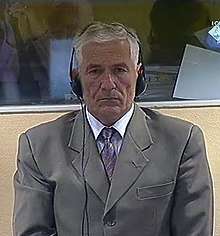Serbian Army of Krajina
The Serbian Army of Krajina (Serbian: Српска војска Крајине/ lat. Srpska vojska Krajine) was the armed forces of the Republic of Serbian Krajina (RSK). Also known as the Army of the Republic of Serb(ian) Krajina or Krajina Serb Army, the armed forces of Krajina consisted of ground and air elements.
| Serbian Army of Krajina | |
|---|---|
Српска Војска Крајине (СВК) Participant in Croatian War of IndependenceSrpska Vojska Krajine (SVK) | |
| Allegiance | |
| Colors | (Serbian tricolour) |
| Battles and war(s) | Operation Coast-91, Battle of Vukovar, Operation Medak Pocket, Operation Winter '94, Operation Maslenica, Operation Summer '95, Operation Flash, Operation Storm |
| War Flag |  |
Created through the merger of the Territorial Defense of the Republika Srpska Krajina (TORSK), units of the Yugoslav People's Army (JNA) and the Krajina Militia, the Krajina Serb Army was officially established on 19 March 1992. Responsible for the security of the RSK, its area of responsibility covered an area of some 17,028 km² at its peak, as it was located entirely inland it thus had no naval forces. The Serbian Army of Krajina, along with the state of RSK, ceased to exist in 1995 following the Croatian military offensive Operation Storm.
Organization
Commanders-in-Chief
| No. | Commander-in-Chief | Took office | Left office | Time in office | |
|---|---|---|---|---|---|
| 1 | Milan Babić (1956–2006) | 1992 | 1992 | 0 years | |
| 2 | Goran Hadžić (1958–2016) | 1992 | 1994 | 1–2 years | |
| 3 | Milan Martić (born 1954) | 1994 | 1995 | 0–1 years |
Commanders
| No. | Commander | Took office | Left office | Time in office | |
|---|---|---|---|---|---|
| 1 | Major General Mile Novaković (1950–2015) | 1992 | 1994 | 1–2 years | |
| 2 | Major General Milan Čeleketić (born 1946) | 1994 | 1995 | 0–1 years | |
| 3 | General Mile Mrkšić (1947–2015) | 1995 | 1995 | 0 years |
Structure
- 105th Aviation Brigade
- 44th Air defense rocket brigade
- 75th Mixed artillery brigade
- "Pauk" Operational Group
- Special forces corps
- 7th Dalmatia (dalmatinski) corps
- 15th Lika (lički) corps
- 21st Kordun (kordunski) corps
- 39th Banija (banijski) corps
- 18th West-Slavonia (zapadnoslavonski) corps
- 11th East-Slavonia (istočnoslavonski) corps
At the creation of the army, it was planned that its number would be 80,000 people, however it turned out to be less.
- According to Colonel Kosta Novaković: 62,483 (772 officers, 2,709 non-commissioned officers and 59,002 soldiers) or 78% of the planned number.[1]
- According to the General Staff in 1994: 62,805 (2,890 officers, 4,329 non-commissioned officers and 55,886 soldiers).[2]
- According to General Milisav Sekulić: 71,409 (3,291 officers, 3,424 non-commissioned officers and 60,496 soldiers).[2]
Mercenaries and paramilitary
There were around 700 former JNA officers, mostly from Serbia and Montenegro, that fought on RSK's side. Foreign fighters were mostly from Russia.[3] Paramilitary organizations established in Serbia (but including Croatian Serb volunteers) supporting the RSK were White Eagles (Beli orlovi), Serb Volunteer Guard (known as Tigrovi), Serbian Guard (Srpska garda), and others.
Equipment
- Armored Vehicles
- Artillery
- Anti-aircraft
- Aircraft
- An-2 (1)
- J-20 Kraguj
- Soko J-22 Orao (2)
- J-21 Jastreb (12)
- G-2 Galeb
- Aérospatiale Gazelle
- Mil Mi-8T
- Utva 66
- Zlin Z-526
- Other
Gallery
 Krajina Airforce G-2 Galeb
Krajina Airforce G-2 Galeb Krajina Airforce Aérospatiale Gazelle
Krajina Airforce Aérospatiale Gazelle- Krajina Airforce Utva 66
 Krajina Airforce Zlin Z-526
Krajina Airforce Zlin Z-526
See also
References
- Novaković 2009, p. 292.
- Рат за опстанак Срба Крајишника. Зборник радова 1. - Београд: Тело Принт. - 2010, с. 199.
- "Use of mercenaries as a means of violating human rights and impeding the exercise of the right of peoples to self-determination – Note by the Secretary-General". United Nations. 29 August 1995. Retrieved 23 January 2011.
Sources
- Vrcelj, Marko (2002). Rat za Srpsku Krajinu: 1991-1995. Zora.
- Novaković, Kosta (2009). Srpska krajina: usponi, padovi, uzdizanja. Zora. ISBN 978-86-83809-54-7.
- "The Army of Serbian Krajina", Jane's Intelligence Review, 1 October 1993
External links
- "Vojska Republike Srpske Krajine". Archived from the original on 30 December 2008.


